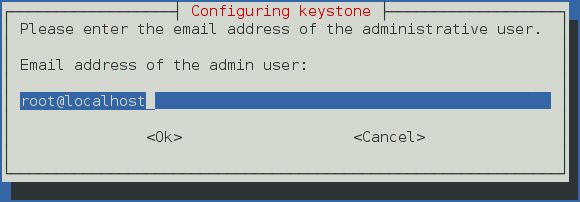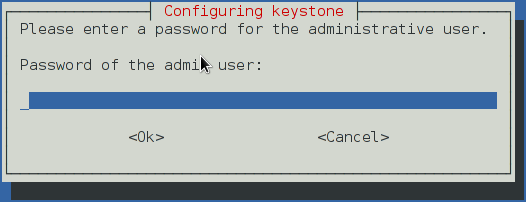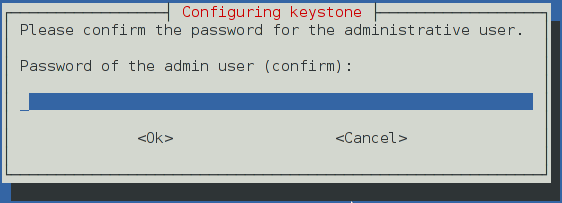Install and configure¶
This section describes how to install and configure the OpenStack Identity service, code-named keystone, on the controller node. For performance, this configuration deploys Fernet tokens and the Apache HTTP server to handle requests.
Install and configure the components¶
Run the following command to install the packages:
# apt-get install keystoneRespond to prompts for Configure the database with dbconfig-common, which will fill the below database access directive.
[database] ... connection = mysql+pymysql://keystone:KEYSTONE_DBPASS@controller/keystone
If you decide to not use
dbconfig-common, then you have to create the database and manage its access rights yourself, and run the following by hand.# keystone-manage db_syncGenerate a random value to use as the administration token during initial configuration:
$ openssl rand -hex 10
Configure the initial administration token:

Use the random value that you generated in a previous step. If you install using non-interactive mode or you do not specify this token, the configuration tool generates a random value.
Later on, the package will configure the below directive with the value you entered:
[DEFAULT] ... admin_token = ADMIN_TOKEN
Create the
adminproject and user:During the final stage of the package installation, it is possible to automatically create an
adminandserviceproject, and anadminuser. This can later be used for other OpenStack services to contact the Identity service. This is the equivalent of running the below commands:# export OS_BOOTSTRAP_USERNAME=${ADMIN_USER_NAME} # export OS_BOOTSTRAP_PROJECT_NAME=${ADMIN_TENANT_NAME} # export OS_BOOTSTRAP_PASSWORD=${ADMIN_USER_PW} # keystone-manage bootstrap # export OS_PROJECT_DOMAIN_ID=default # export OS_USER_DOMAIN_ID=default # export OS_USERNAME=admin # export OS_PASSWORD=${ADMIN_USER_PW} # export OS_TENANT_NAME=${ADMIN_TENANT_NAME} # export OS_PROJECT_NAME=${ADMIN_TENANT_NAME} # export OS_AUTH_URL=http://127.0.0.1:35357/v3/ # export OS_IDENTITY_API_VERSION=3 # export OS_AUTH_VERSION=3 # export OS_PROJECT_DOMAIN_ID=default # export OS_USER_DOMAIN_ID=default # export OS_NO_CACHE=1 # openstack project set \ --description "Default Debian admin project" \ $ADMIN_TENANT_NAME # openstack project create --or-show service \ --description "Default Debian service project" # openstack user set \ --description "Default Debian admin user" \ --email ${ADMIN_USER_EMAIL} \ --enable $ADMIN_USER_NAME
The Keystone package will then create roles for
admin,KeystoneAdmin,KeystoneServiceAdmin,heat_stack_owner,MemberandResellerAdmin, and will add them to theadminproject. For each of these, it is equivalent to:# openstack role create --or-show FOO # openstack role add --project admin \ --user admin FOO





Register the keystone endpoint
In Debian, the Keystone package offers automatic registration of Keystone in the service catalogue. This is equivalent of running the below commands:
# OS_TOKEN=`openstack token issue -c id -f value` \ openstack service create \ --os-url=http://127.0.0.1:35357/v3/ \ --name keystone \ --description "OpenStack Identity" \ identity # OS_TOKEN=`openstack token issue -c id -f value` openstack endpoint create \ --os-url=http://127.0.0.1:35357/v3/ \ keystone public http://controller:5000/v2.0 # OS_TOKEN=`openstack token issue -c id -f value` openstack endpoint create \ --os-url=http://127.0.0.1:35357/v3/ \ keystone internal http://controller:5000/v2.0 # OS_TOKEN=`openstack token issue -c id -f value` openstack endpoint create \ --os-url=http://127.0.0.1:35357/v3/ \ keystone admin http://controller:35357/v2.0


Except where otherwise noted, this document is licensed under Creative Commons Attribution 3.0 License. See all OpenStack Legal Documents.